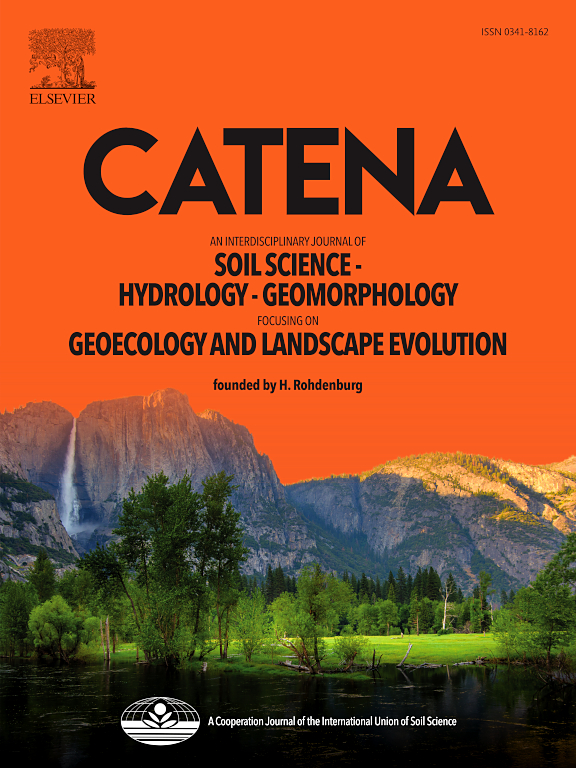中国黄土高原温带森林演替阶段形成土壤原生生物群落动态的组合过程
IF 5.4
1区 农林科学
Q1 GEOSCIENCES, MULTIDISCIPLINARY
引用次数: 0
摘要
原生生物作为土壤食物网的关键调节者,维持着各种生态系统的功能。然而,它们在植物演替过程中的组装动态仍然知之甚少,这阻碍了将原生生态整合到恢复框架中。利用18S rRNA测序技术,研究了黄土高原子武岭地区160年森林演替过程中土壤原生生物群落的动态变化,量化了群落组装过程的贡献,并确定了关键驱动因素。结果表明,在演替过程中,确定性过程主导着原生生物群落的聚集,均匀选择(73.29% ~ 76.51%)从草地到混交林逐渐减少(P <;0.05),但在顶极林中略有增加(P >;0.05),受凋落物/根系输入、土壤性质和林下光照的调节。在混交林中,随机过程,特别是扩散限制,瞬时增加(贡献18.21%),与最大的植物多样性和高度的环境异质性相一致,增强了原生生物β-多样性(布雷-柯蒂斯不相似性)。尽管原生生物α-多样性保持稳定,但随着演替的进行,功能发生了变化:食用菌减少(75.86% ~ 62.40%),寄生菌增加(24.06% ~ 37.57%),光养菌受到林下光照减少的抑制。共现网络由稀疏(草地)向密集(顶极森林)过渡,边缘数从519增加到1331,正相关从58.57%增加到90.83%。在整个演替过程中,土壤养分(如易氧化碳、全氮)和植物源资源(如凋落物/根系有机碳)持续推动原生生物的聚集,而土壤容重(1.22 g/cm3)和湿度(12.83%)等非生物因素决定了早期演替,生物调节(如微生物生物量)主导了后期演替。这些发现揭示了植物演替如何重构原生群落,为黄土高原等干旱/半干旱地区土壤生物多样性恢复和生态系统恢复提供了重要见解。本文章由计算机程序翻译,如有差异,请以英文原文为准。
Unraveling assembly processes shaping soil protist community dynamics across successional stages of temperate forests on the Chinese Loess Plateau
Protists, as pivotal regulators of soil food webs, maintain various ecosystem functioning. However, their assembly dynamics during plant succession remain poorly understood, hindering the integration of protist ecology into restoration frameworks. This study investigated the dynamics of soil protist communities along a 160-year forest succession chronosequence in the Ziwuling region of the Chinese Loess Plateau via 18S rRNA sequencing, quantifying assembly processes contributions and identifying key drivers. Results showed that deterministic processes dominated protist community assembly across succession, with homogeneous selection (73.29 %–76.51 % contribution) decreasing gradually from grasslands to mixed forests (P < 0.05) but increasing moderately in climax forests (P > 0.05), mediated by litter/root inputs, soil properties and understory light. Stochastic processes, particularly dispersal limitation, increased transiently in mixed forests (18.21 % contribution), aligning with maximal plant diversity and heightened environmental heterogeneity, which enhanced protist β-diversity (Bray-Curtis dissimilarity). Despite stable protist α-diversity, functional shifts emerged with succession: consumers declined (75.86 % to 62.40 %) while parasites increased (24.06 % to 37.57 %), with phototrophs suppressed by reduced understory light. Co-occurrence networks transitioned from sparse (grasslands) to densely connected (climax forests), showing increased edge number (519 to 1331) and positive correlations (58.57 % to 90.83 %). Soil nutrients (e.g., readily oxidizable carbon, total nitrogen) and plant-derived resources (litter/root organic carbon) persistently drove protist assembly throughout succession, while abiotic factors like soil bulk density (1.22 g/cm3) and moisture (12.83 %) shaped early-succession and biotic regulation (e.g., microbial biomass) dominated late-succession. These findings demonstrate how plant succession restructures protist communities, providing critical insights for soil biodiversity recovery and ecosystem restoration in arid/semi-arid regions like the Loess Plateau.
求助全文
通过发布文献求助,成功后即可免费获取论文全文。
去求助
来源期刊

Catena
环境科学-地球科学综合
CiteScore
10.50
自引率
9.70%
发文量
816
审稿时长
54 days
期刊介绍:
Catena publishes papers describing original field and laboratory investigations and reviews on geoecology and landscape evolution with emphasis on interdisciplinary aspects of soil science, hydrology and geomorphology. It aims to disseminate new knowledge and foster better understanding of the physical environment, of evolutionary sequences that have resulted in past and current landscapes, and of the natural processes that are likely to determine the fate of our terrestrial environment.
Papers within any one of the above topics are welcome provided they are of sufficiently wide interest and relevance.
 求助内容:
求助内容: 应助结果提醒方式:
应助结果提醒方式:


